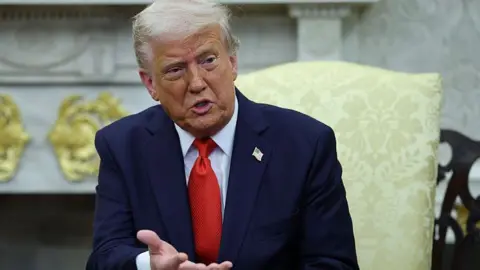[ad_1]
Business reporter, BBC News
 Getty Images
Getty ImagesThe US growth forecast for this year has been given the biggest downgrade among advanced economies by the International Monetary Fund (IMF) as a result of uncertainty caused by trade tariffs.
Growth is now expected to be 1.8% this year, down from the IMF’s estimate of 2.7% for the US in January.
The sharp increase in tariffs and uncertainty will lead to a “significant slowdown” in global growth, the Fund predicts.
The forecast for the UK has also been cut, with the economy now expected to grow by 1.1% this year.
The predictions come as top economic policymakers gather in Washington for the spring meetings of the IMF and World Bank.
IMF chief economist Pierre-Oliver Gourinchas said the global economy “still bears significant scars” from the “severe shocks of the past four years”.
“It is now being severely tested once again,” he added.
President Donald Trump has made a flurry of announcements on tariffs this year – taxes charged on goods brought into the US from other countries.
In a growing trade war, the US has placed tariffs of up to 145% on Chinese goods, while China has hit back with 125% on US products.
The US has also introduced a 10% tax on goods from the vast majority of other countries, while pausing much higher rates for dozens of nations for 90 days.
Trump says tariffs will encourage US consumers to buy more American-made goods, increase the amount of tax raised and lead to huge levels of investment in the country.
However, the IMF highlighted the potential negative impact on global trade given that modern supply chains are so interlinked.
Uncertainty around trade policy was a “major factor” behind the growth downgrades, Mr Gourinchas said.
“Faced with increased uncertainty… many firms’ initial reaction will be to pause, reduce investment and cut purchases.”
The IMF predicts the global economy will grow by 2.8% this year, down from its previous forecast of 3.3%, and by 3.0% in 2026.
The downgrade to the US growth forecast was due to greater policy uncertainty, trade tensions and slower than expected consumer spending, the IMF said. Tariffs are also expected to hit growth in 2026.
China is expected to grow by 4% this year, down from the IMF’s previous estimate of 4.6%.
In the UK, the downward revision reflects the impact of tariffs, higher government borrowing costs, and weaker consumer spending as a result of higher bills and energy costs.
However, the IMF’s 2025 prediction for the UK is now close to the 1% growth forecast by the government’s Office for Budget Responsibility (OBR) last month. The IMF expects the UK to grow by 1.4% next year.
Responding to the forecast, Chancellor Rachel Reeves said it showed the UK was still the fastest growing European G7 country.
The IMF’s World Economic Outlook also contains the following forecasts:
- The eurozone growth prediction is trimmed to 0.8% for this year from 1%. It is then set to grow by 1.2% in 2026, helped by higher government spending in Germany
- Spain is the only advanced economy to see its 2025 growth forecast upgraded – to 2.5% from 2.3%. This is partly due to reconstruction activity following floods
- Canada’s growth forecast for this year is cut to 1.4% from 2%, reflecting tariff uncertainty and “geopolitical tensions”
- Mexico sees the biggest downgrade. It is now predicted to contract by 0.3% this year, compared with January’s forecast of 1.4% growth.
Forecasts are never perfect given the many factors that affect economic growth, and the IMF acknowledged its latest predictions had been particularly challenging.
The figures given are what the IMF calls its “reference forecast” based on the situation as at 4 April, which was two days after Trump’s announcement of wide-ranging tariffs.
Mr Gourinchas said that while the reference forecast was the IMF’s central scenario, “many possible paths exist, reflecting the unpredictability surrounding future trade policy and the varied impact of tariffs across different countries”.
The IMF also looked at the situation after the US temporarily suspended many tariffs while raising those on China sharply.
Mr Gourinchas said the tariff pause did not “materially” change the global outlook from its reference forecast, because the overall effective tariff rate of the US and China remains high and uncertainty about the policy continues.
[ad_2]
Source link




